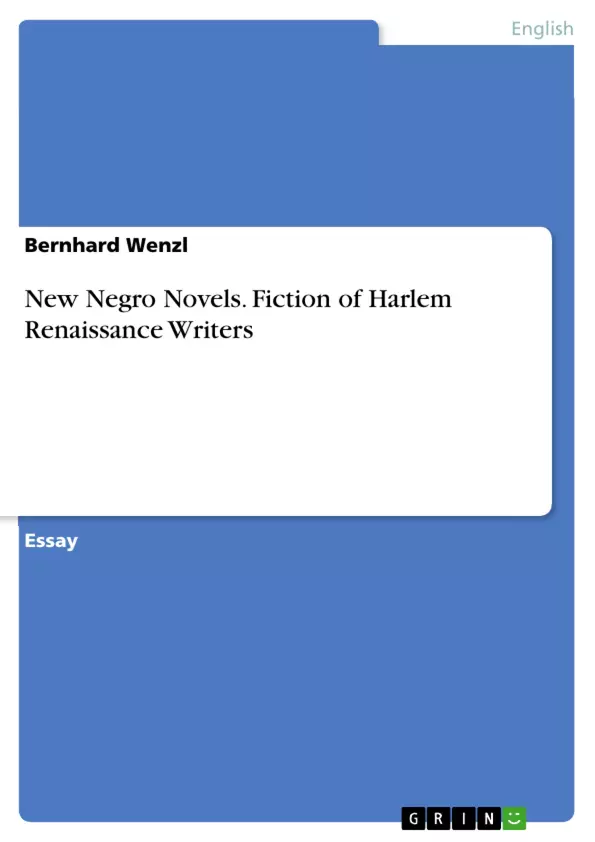Harlem had evolved into a buzzing centre of Afro-American culture and art at the beginning of the 20th century. Racism, segregation and discrimination in the agricultural South of the United States had driven hundred thousands of Afro-Americans into the industrial cities of the North. Additionally, the First World War had led to a tremendous labour shortage that could only be balanced by intense migration, education and employment of black farm workers. Just like other American cities at the time, New York saw the development of an urban district with a predominantly black population. Located in the northern part of Manhattan, Harlem had almost two hundred thousand inhabitants in 1925 and covered an area of more than two square miles. This busy quarter not only supplied the entire infrastructure of modern city life but also provided the human capital and institutional resources of the New Negro Movement.
The New Negro Movement of the 1920s and 1930s brought Harlem Renaissance fiction to full bloom. Political concerns found their way into the early novels but were increasingly supplanted by artistic intentions. Torn between social uplifting and individual expression, the novelists became more and more daring in their treatment and representation of Afro-American issues. Today the Harlem Renaissance is regarded as a crucial period in the history of Afro-American literature. Its representatives used a wide range of traditional and modern narrative and stylistic techniques to produce a variety of first-rate works. Even if the civil rights movement in the 1950s dismissed some of their novels as too conservative, subsequent generations of black authors could take them as creative models.
Inhaltsverzeichnis (Table of Contents)
- Novels of prominent NAACP members
- Jessie Redmon Fauset
- Walter Francis White
- Promising Harlem Renaissance authors
- Claude McKay
- Nella Larsen
- Wallace Thurman
- Zora Neale Hurston
Zielsetzung und Themenschwerpunkte (Objectives and Key Themes)
This text examines the development of Harlem Renaissance fiction, focusing on the novels of prominent NAACP members and other promising authors of the period. It explores the intersection of political concerns, artistic aspirations, and the representation of Afro-American issues within these novels.
- The impact of racism and discrimination on the lives of African Americans
- The role of the Harlem Renaissance in promoting African American culture and identity
- The use of narrative and stylistic techniques to address social and political issues
- The evolution of Afro-American literature and its influence on subsequent generations of writers
- The portrayal of gender, class, and colorism within the Harlem Renaissance
Zusammenfassung der Kapitel (Chapter Summaries)
- Novels of prominent NAACP members
- Jessie Redmon Fauset’s There Is Confusion explores the challenges faced by three young African Americans navigating a society riddled with ethnic discrimination. The novel critiques social prejudices while incorporating sentimental plot elements.
- Walter Francis White’s The Fire in the Flint delves into the devastating effects of racist violence and oppression in the American South. The plot centers on a black doctor who faces conflict with white landowners and ultimately falls victim to the Klu Klux Klan.
- Promising Harlem Renaissance authors
- Claude McKay’s Home to Harlem recounts the experiences of Jake Brown, an African American soldier who returns to Harlem after deserting the U.S. Army. This urban novel portrays the realities of the black underclass with a sympathetic tone.
- Nella Larsen’s Passing explores the complex relationship between two light-skinned black women navigating different social worlds. The novel examines the impact of skin color on identity and is considered a literary masterpiece of the Harlem Renaissance.
- Wallace Thurman’s The Blacker the Berry satirically explores the theme of colorism within the African American community. The protagonist, Emma Lou Morgan, faces prejudice and discrimination due to her dark skin color, highlighting the internalized racism present even among African Americans.
Schlüsselwörter (Keywords)
The key themes and concepts explored in this text include: Harlem Renaissance, African American literature, racism, discrimination, social criticism, identity, colorism, urban life, narrative techniques, literary movements, and the impact of social and political contexts on literature.
- Quote paper
- Mag. Bernhard Wenzl (Author), 2016, New Negro Novels. Fiction of Harlem Renaissance Writers, Munich, GRIN Verlag, https://www.grin.com/document/314307



